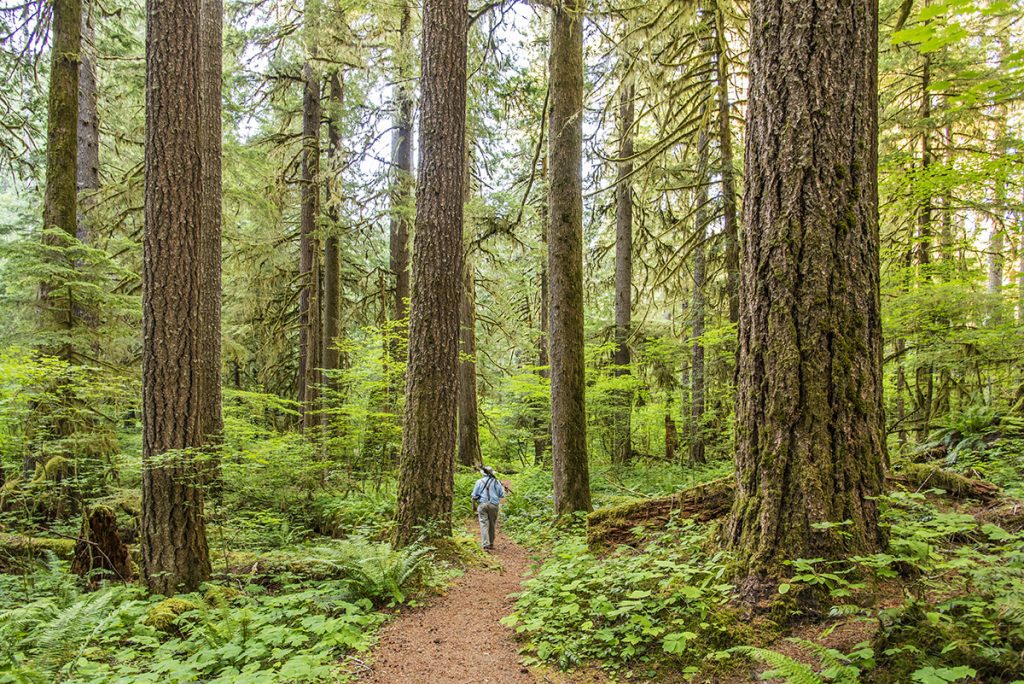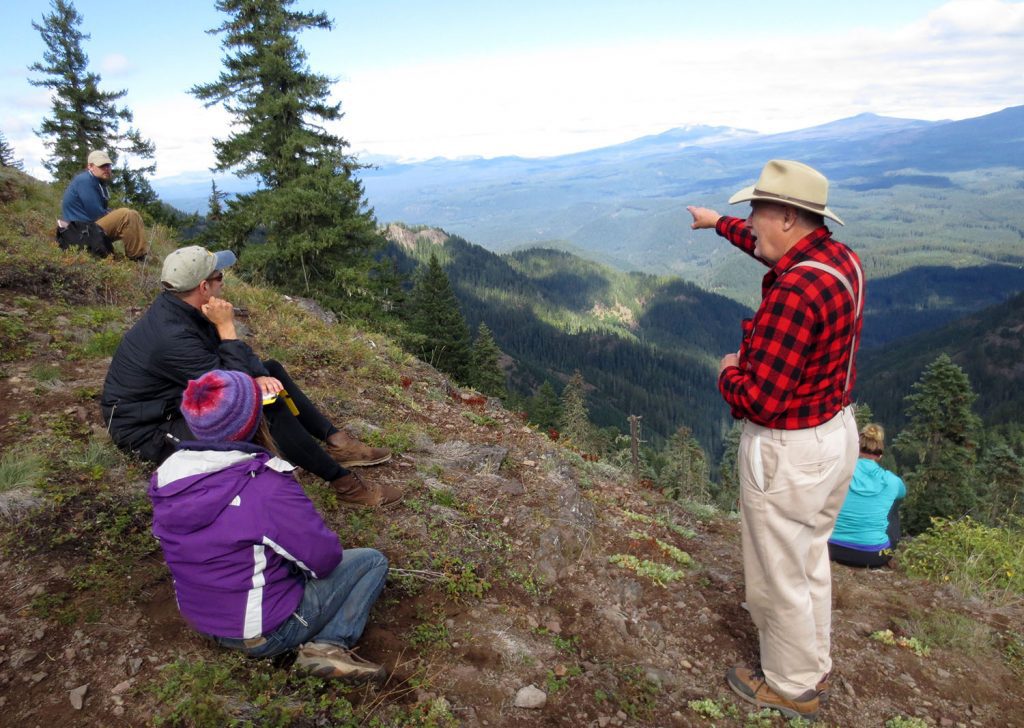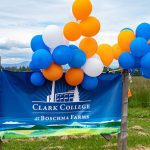‘The guru of old growth’ has roots in Clark College
6 minute read
World renowned forest ecologist Jerry Franklin launches his career at Clark College, learning from Dr. Anna Pechanec, the namesake of one of Clark’s science buildings

Jerry Franklin’s ’55 research changed how we view old growth forests and shifted the conversation about climate change. Photo by James Pipkin
Jerry Franklin ’55 grew up in Camas in the 1940s and 50s when it was a blue-collar mill town of fewer than 5,000 people, and the behemoth Crown Zellerbach paper mill infused everything—from the pungent air to the name of Camas High School’s sports teams, the Papermakers.
“Everybody either worked at the paper mill or depended on it,” Franklin said.
“It was the largest specialty paper mill in the world. My dad worked there. His dad worked there. And I worked there.”
But Franklin dreamed of a different path. It was on family camping trips in the Gifford Pinchot National Forest, walking beneath the canopy of towering old growth trees, that the boy whose middle name was “Forest” felt most at home. It wasn’t simply that he liked being in the woods. His connection was deeper than that. He felt kinship with big trees. Trees were his friends. The boy realized his calling and spoke out loud, to the trees. He vowed to spend his life protecting them.
Franklin wanted to attend college. His parents supported his decision but didn’t have money to pay for it. Franklin worked on a fire crew for two summers, earning $125 a month minus the cost of boarding. When he graduated from Camas High School in 1954, he had saved enough to enroll at Clark College.
Franklin spent one year at Clark, the first step in a long career that changed the way the rest of us view old growth forests. Franklin went on to become a world-renowned forest ecologist, publishing more than 300 scientific articles and books. His research changed the way forests are managed—and as a result, reshaped entire communities that once centered on mills designed to chop huge trees into lumber.
Father of new forestry
Franklin is now 85 years old. His work has led to the protection of millions of acres of trees. He’s been dubbed “the father of new forestry” and “the guru of old growth forests.” He is still leading the call to protect old growth forests, still speaking up about the importance of preserving old trees—both living and decaying—to mitigate the effects of climate change.
Although he spent only one academic year at Clark College, Franklin described his time there as “profound.” When Franklin stepped onto Clark’s campus in fall 1954, he found a community where he thrived.
“My time at Clark was tremendous,” he said. “In high school, I was bored, inattentive. I had excelled at some things but didn’t do well overall. College was more suited to my way of learning.”
He appreciated being immersed in new subjects and new ideas. He liked meeting people and making friends. His confidence grew and he ran for ASCC president but didn’t win. He also met his first wife, Carol Ann Jarrett, a fellow student who worked in the bookstore. He bought a pencil from her every day so he could talk to her. Later they married and raised a family together.
“I’m grateful for my year at Clark and the teachers I had here,” Franklin said. “I maintain that for basic classes, you get better teaching at a community college than a four-year institution.”
Professor’s profound affect
The Clark instructors he appreciated most were chemistry professor Roland Dietmeier and biology professor Dr. Anna Pechanec. Their classes were challenging and engaging.
In Pechanec, Franklin found a mentor and kindred spirit. Franklin had spent his formative years camping amid big trees, but Pechanec had spent her life studying them. She was an expert on Northwest native plants—from towering old growth Douglas firs to the much smaller mosses, lichens and liverworts, her specialty. Franklin credits Pechanec with helping him develop the research skills that formed the foundation of his career.
Franklin and Pechanec began doing field research together in old growth forests in Southwest Washington. Over several years they recorded 350 plots all over the Gifford Pinchot National Forest.
“We’d find stands, lay out a plot, sample it and observe what species were there. We did a complete inventory of trees, species and sizes. I collected data on trees and shrubs. She collected data on mosses, lichens and liverworts. Previously, the Forest Service did timber inventories, but never ecological inventories.”
Their work laid the foundation for Franklin’s later groundbreaking research that halted logging old growth forests in favor of maintaining them as precious ecosystems.
After his year at Clark, Franklin transferred to what is now Oregon State University, where he earned bachelor’s and master’s degrees in forest management. He then earned a doctorate in botany and soils from Washington State University.
Ground-breaking forestry research
Toward the tail end of his bachelor’s program, Franklin spent a summer doing research with the U.S. Forest Service.
“Research was a perfect fit for me,” he said.
Franklin was hired by the agency as a research forester in 1959. At the time, old growth forests were believed to be biological deserts. Under the U.S. Department of Agriculture, the Forest Service managed forests as a timber commodity or a crop to be harvested. The most efficient method was clear cutting. Enormous swaths of forest on federal land had been logged over decades.
Building upon the ecological inventory system he practiced with Pechanec, Franklin began studying old growth forests. His findings were not just unexpected, they shattered the accepted beliefs about old growth forests. He was the lead author on a 50-page research paper, “Ecological Characteristics of Old Growth Douglas Fir Forests” (USDA Forest Service, 1981). This groundbreaking work stated that old growth forests were not biological deserts at all, but vibrant ecosystems. The paper also noted that old, dead trees—still-standing snags and fallen logs decaying on the forest floor—were essential for the health of the ecosystem.
Franklin’s research findings helped ramp up the Pacific Northwest timber wars, a showdown between environmentalists who wanted to save the northern spotted owl—a species that relied on the old growth ecosystem—and the timber industry that relied on the profit margins of huge old trees.
Wanted: Dead or Alive
Franklin made enemies with the timber industry and environmentalists alike. Some environmentalists disagreed with Franklin’s willingness to selectively cut trees in managed forests. He received death threats. “Wanted: Dead or Alive” posters with his name and photo were displayed in the logging community of Forks, Wash.

Jerry Franklin’s findings were not just unexpected. They shattered the accepted beliefs about old growth forests. He’s seen here teaching in Gifford Pinchot National Forest in 2013. Photo by James Pipkin
Through his original research, Franklin became a world-renowned authority on old growth forests and their importance to a healthy, sustainable ecosystem. He served as a panelist at the White House Forest Conference in 1993. He was appointed by President Bill Clinton as one of four lead scientists, dubbed the “gang of four” by the critics, to draft the Northwest Forest Plan, a guideline for managing old growth forests and maintaining their rich ecosystems.
Due to protests by environmentalists, lawsuits, effects on the northern spotted owl and more, the U.S. Forest Service stopped logging in old growth forests on federal land in Western Washington and Oregon.
Speaks out for trees
But Franklin hasn’t stopped speaking up for old trees. Recently, when he learned the Forest Service proposed logging almost 2,000 acres of mature trees, 100 to 150 years old, in the Willamette National Forest in Oregon, he co-wrote a guest editorial in The Eugene Register-Guard with longtime colleague Norm Johnson.
They wrote: “There are no ecological justifications for harvesting more than 2,000 acres of mature forest … It is time to stop logging magnificent mature forests … once and for all. These forests simply contribute too much ecologically, socially and spiritually in their current state.”
Sitting in Gaiser Hall on Clark College’s campus one June morning, Franklin explained his philosophy about trees and logging: “I’m an advocate for preserving what’s left of our mature forests. But I also believe in managing the forests we have cut, for the benefit of the forests and humanity. The bottom line is maintaining the integrity of the ecosystems, not timber production.”
Teaching the next generation
Franklin taught the next generation of foresters at Oregon State University and later at University of Washington. He took his UW students to some of the research sites where he and fellow scientists collaborated over decades. After Franklin retired, assistant professor Brian Harvey continued his field work. Franklin’s dedication to measuring individual trees and collecting data in long-term forest management plots has provided evidence of the acceleration of climate change.
Harvey said, “Now that we’re seeing the effects of climate change manifest so rapidly, those long-term measurements are so important to being able to understand what we’re observing today. It is incredibly humbling to carry forward some of the long-term work that Jerry and his collaborators have invested in for many years. Jerry’s insights on forest ecology have been profound and far reaching.”
As he approaches his 86th birthday, Franklin’s lifelong commitment to protect the trees has not wavered. He continues his work: writing opinion pieces against logging in old growth forests, speaking about how old trees can reduce the effects of climate change and spending time underneath the canopy of old trees. He still retreats to his nearly century-old cabin nestled in old growth forest in the Gifford Pinchot National Forest, not far from where he camped with his family when he was a boy and first dedicated his life to protecting the trees.
“It’s still my favorite place to be,” he said.
Written by Susan Parrish, a journalist who writes about education, the environment, economic opportunity and living simply.



